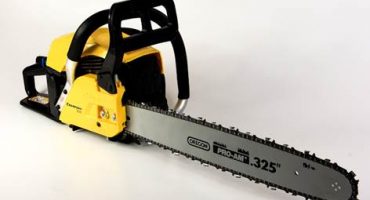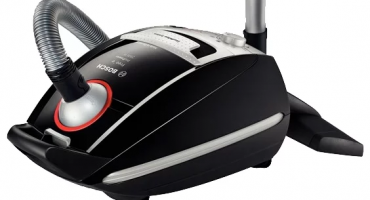Drinking fresh juice is a pleasant way to enrich your body with vitamins. But first you need to choose a juicer, and this is not as simple as it seems. All juicers are divided into two large groups: screw and centrifugal. Therefore, you need to understand how they differ.

Freshly squeezed juices contain many vitamins and few calories
Principle of operation
The screw model can safely be called a meat grinder for fruits and vegetables. It is equipped with a helical shaft that rotates and grinds the raw materials for juice. Screw devices operate at low speeds and cannot be accelerated. Centrifugal force does not form inside the juicer.
The difference between centrifugal devices is that they work more accurately. At high speeds, the juice is separated from the pulp. When you turn on the juicer, it starts to work like a centrifuge. Its contents are pressed against the walls at high speed and due to this, the formation of juice. The resulting liquid flows into the glass through the provided holes.
Advantages and disadvantages
Each type of juicer has its own supporters and opponents. But despite this, we can highlight their main pros and cons.
Pros of screw juicers:
- Juice is formed at low speeds and therefore does not oxidize. Thanks to this, all the useful properties of the product are preserved.
- Ready juice can be stored for 48 hours. It will not deteriorate and will retain its benefit.
- Such devices have a wide neck. This prevents them from sliding around the table. And also, even with maximum filling, the products will not fall over the edge.
- The included juicer makes almost no noise.
- Screw juicers can be used continuously for half an hour. Their working parts are not destroyed by the force of rotation, and serve much longer.
- Self-cleaning function. In order to clean the device after work? you need to spend just a few minutes.
- Most pulp is processed into juice. There is almost no waste.
- You can add herbs, berries and cereals to the juice, as well as make nut or soy milk.
Cons of a screw juicer
- The juice is concentrated and with a high pulp content. Those who like a less saturated product will have to use a sieve or recycle it several times.
- If you load too soft fruits into the device, they will not produce juice, but puree.
- The products will have to be cut before laying if the juicer has too small a hole.
- The screw device is unlikely to be suitable for commercial purposes. It can not be used without a break for more than 30 minutes. Longer use will speed up wear on parts.
- Vertical models cannot squeeze tomato juice. Tomatoes can only be processed on horizontal juicers.
Pluses of centrifugal models:
- Juice is produced very quickly, because the device can reach up to 40,000 rpm.
- Such a device costs lower than screw devices.
- The wide neck allows even large ingredients to be used. This greatly simplifies the process of making juices. You just need to load vegetables or fruits and start the device.
Cons of centrifugal models:
- The juice is very hot during the spin process. Because of this, many vitamins and trace elements are destroyed.
- In a working centrifuge, the juice interacts with air, so it turns out to be foamy.
- The finished product is oxidized almost immediately from being in contact with oxygen.
- The resulting juice must be drunk within 20 minutes, otherwise it will lose its taste and healthy properties.
- The pulp will remain on the walls. Therefore, for the preparation of juice will need more raw materials. For example, you need five or six apples in order to get one glass of juice.
It cannot be said unequivocally that a screw auger is better or a centrifugal one is more convenient. Each of them has its own characteristic advantages and disadvantages. Both types of devices easily process hard vegetables and fruits, such as carrots, oranges or apples. But lovers of tomato juice will have to make a choice in favor of a centrifugal model.
An inexpensive centrifugal juicer is suitable for those who are not going to experiment with products. To judges of exotic juices it is more reasonable to choose the screw device. With it, you can make juice from grapes or herbs. This device will cost more, but with it you can save energy and do with fewer products.
It is impossible to say which juicer is better, but it is better to study the known screw or centrifugal devices. This will help you make the right choice.
Popular models of screw juicers
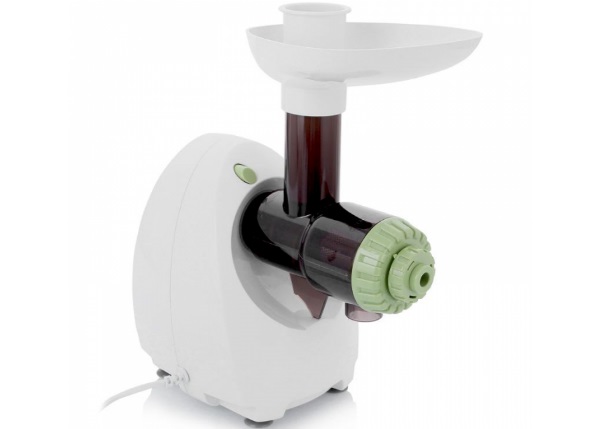
VES 3005
The Korean VES 3005 juice extractor is known not only in its homeland. This device has one horizontal auger, which can reach speeds of up to 200 revolutions per minute. The body of the device is made of plastic. And his legs are treated with rubber to prevent slipping. Ready juice is poured into a glass. Included with the juicer is a tray for convenient loading of products. The average price of this model is 3600 rubles.
Ves 3005
Benefits:
- Low cost.
- High strength case.
- Great performance up to 200 rpm.
- Low power consumption, only 1,500 kW.
- Convenient vessel for the resulting juice
- Low noise.
Omega TWN32
Juicer with two screws. This device is much more expensive, about 34500 rubles, and has more advanced features. The squeezed liquid is supplied directly, and the spent pulp is automatically discharged. The device is equipped with surge protection and careless shutdown. Its body is made of reinforced plastic, and the centrifuge is made of stainless steel. High spin quality is achieved with just one speed. The weight of the device is 6 kg, although usually models with such characteristics weigh a couple of kilograms more.
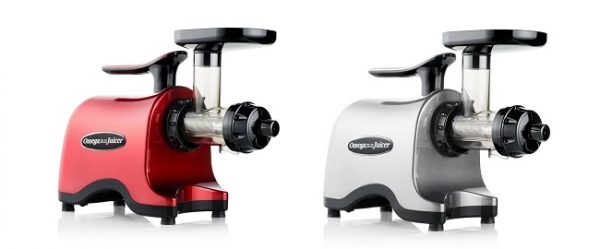
Omega TWN32
Benefits:
- Convenient size.
- One speed is easier to handle.
- Elite appearance.
- Long life centrifuge.
- The power cord collapses and takes up no space.
- Low noise.
Bork s610
Ranked first in many ratings. This juicer has just one screw with a maximum power of 240 watts. The device is controlled by a mechanical module. The panel has a separate button for reverse. The volume of containers for squeezed juice is 1200 ml. And the capacity for the pulp is even larger - its volume is 1.4 liters. To clean the device, two convenient brushes and a convenient pusher are included. The average price is about 30,000 rubles.

Bork s610
Benefits:
- Good value for money.
- One auger with high performance.
- Several body colors.
- Large glass for juice and containers for waste.
Popular centrifugal juicer models
Philips HR1836
The Philips HR1836 juicer has a capacity of 500 watts. The volume of its reservoir for pulp is 1 liter. Due to this, at a time you can get 0.5 liters. juice. Large fruits will have to be cut, because its neck is only 55 mm. The device runs at the same speed. But this is quite enough for most vegetables and fruits.
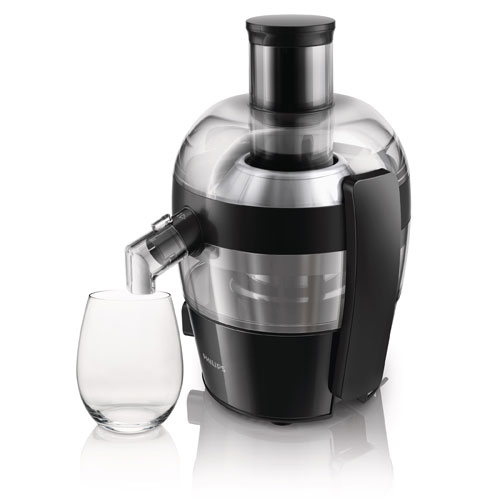
Philips HR1836
Benefits:
- Easy to use and clean.
- Large capacity for pulp.
- Price and quality fit together.
- Compact size.
Bosch MES25A0 / 25C0 / 25G0
It surpasses the absolute majority of models with its power of 700 watts. This juicer has an increased juice capacity of 1.25 liters. It easily absorbs medium-sized apples with its 73 mm neck. It operates at two speeds.
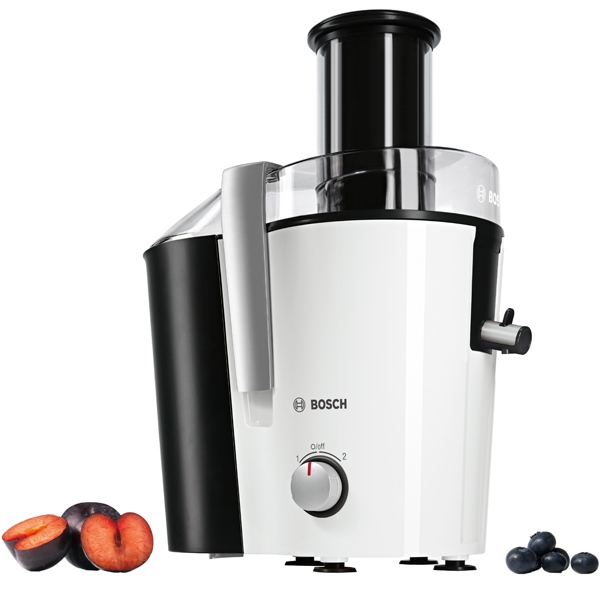
Bosh MES25A0 / 25CO / 25GO
Benefits:
- It works without noise.
- Recycle large volumes.
- A proven brand guarantees reliability.
The Braun J300 Multiquick Centrifugal Juicer is even more powerful than the previous model. Its power is 800 watts, and the size of the reservoir for freshly squeezed juice is 1.25 liters. The pulp container holds 2 liters. Even large fruits pass entirely into its neck with a diameter of 75 mm.
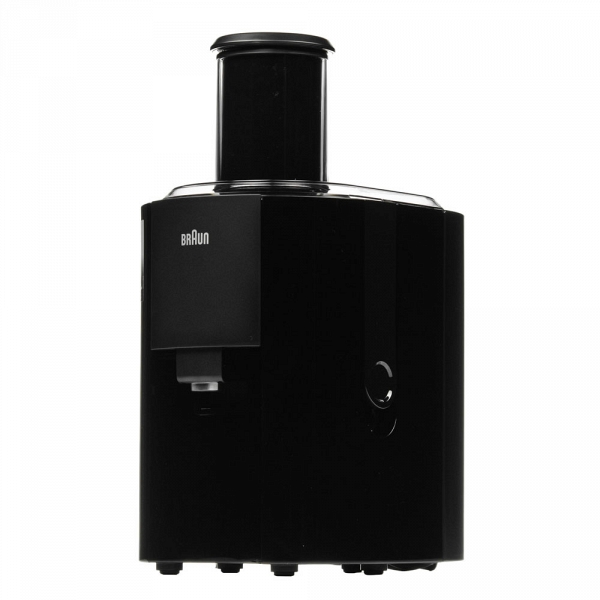
Braun J300 Multiquick
Benefits:
- Two speeds.
- No need to cut products before bookmarking.
- One work cycle gives a lot of fresh juice.


